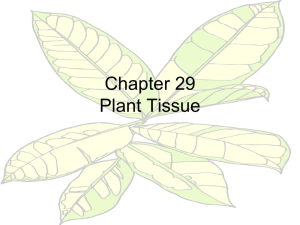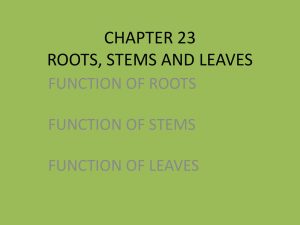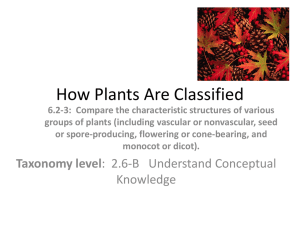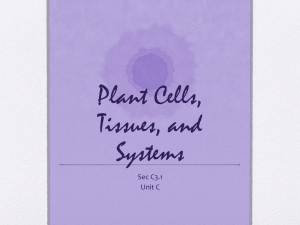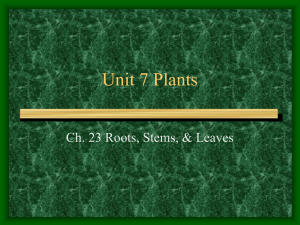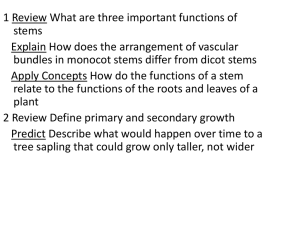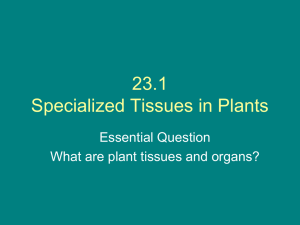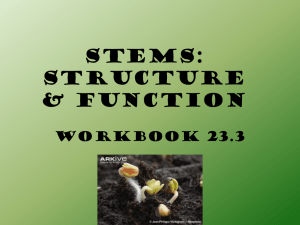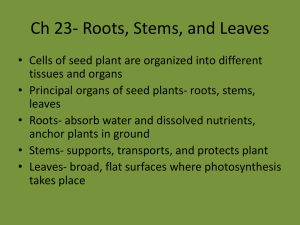Plant Notes
advertisement
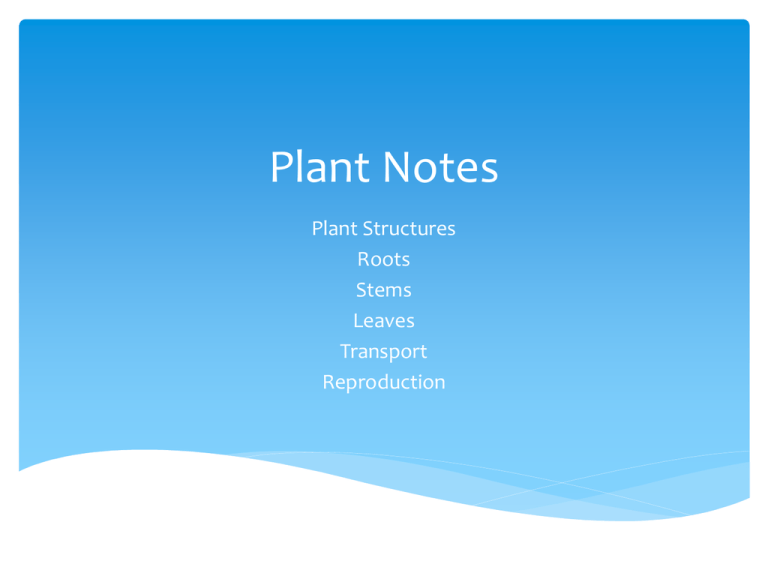
Plant Notes Plant Structures Roots Stems Leaves Transport Reproduction Plant Structures What are the three principal organs of seed plants? The three principal organs of seed plants are roots, stems, and leaves. There are three tissue systems in plants: Dermal Vascular Ground Roots Roots anchor plants in the ground, holding soil in place and preventing erosion. Root systems absorb water and dissolved nutrients. Roots transport these materials to the rest of the plant, store food, and hold plants upright against forces such as wind and rain. Root Systems The two main types of root systems are taproot systems and fibrous root systems. Taproot systems are found mainly in dicots. Dandelions have a taproot system. The large primary root is called a taproot. The taproots of oak and hickory trees grow so long that they can reach water several meters below the surface. For example, a dandelion has a short, thick taproot that stores sugars and starches. Fibrous root systems are found mainly in monocots. Grasses have a fibrous root system. The extensive fibrous root systems produced by many plants help prevent topsoil from being washed away by heavy rain. Anatomy of a Root A mature root has an outside layer of dermal tissue, called the epidermis, and also contains vascular tissue and a large area of ground tissue. The root system plays a key role in water and mineral transport. Anatomy of a Root Dermal Tissue: Epidermis The root’s epidermis performs the dual functions of protection and absorption. Its surface is covered with thin cellular projections called root hairs, which penetrate the spaces between soil particles and produce a large surface area that allows water and minerals to enter. Ground Tissue Just inside the epidermis is a region of ground tissue called the cortex. Water and minerals move through the cortex from the epidermis toward the center of the root. The cortex also stores the products of photosynthesis, such as starch. Ground Tissue A layer of ground tissue known as the endodermis completely encloses the vascular cylinder. The endodermis plays an essential role in the movement of water and minerals into the center of the root Vascular Tissue At the center of the root, the xylem and phloem together make up a region called the vascular cylinder. Dicot roots like the one shown in the figure have a central column of xylem cells. Apical Meristem Roots grow in length when apical meristems produce new cells near the root tips. A tough root cap protects the meristem as the root tip forces its way through the soil, secreting a slippery substance that eases the progress of the root through the soil. Cells at the tip of the root cap are constantly being scraped away, and new root cap cells are continually added by the meristem. Uptake of Plant Nutrients The functions of these essential nutrients within a plant are described below. Active Transport of Dissolved Nutrients The cell membranes of root hairs and other cells in the root epidermis contain active transport proteins. Active transport brings the mineral ions of dissolved nutrients from the soil into the plant. The high concentration of mineral ions in the plant cells causes water molecules to move into the plant by osmosis. Water Movement by Osmosis By using active transport to accumulate mineral ions from the soil, cells of the epidermis create conditions under which osmosis causes water to “follow” those ions and flow into the root, as shown in the figure. Water Movement by Osmosis By using active transport to accumulate mineral ions from the soil, cells of the epidermis create conditions under which osmosis causes water to “follow” those ions and flow into the root, as shown in the figure. Movement Into the Vascular Cylinder The waxy Casparian strip forces water and minerals to move through the cell membranes of the endodermis rather than in between the cells. This enables the endodermis to filter and control the water and dissolved nutrients that enter the vascular cylinder. The Casparian strip also ensures that valuable nutrients will not leak back out. As a result, there is a one-way passage of water and nutrients into the vascular cylinder. Root Pressure As minerals are pumped into the vascular cylinder, more and more water follows by osmosis, producing a strong pressure. Contained within the Casparian strip, the water has just one place to go—up. Root pressure, produced within the cylinder by active transport, forces water through the vascular cylinder and into the xylem. As more water moves from the cortex into the vascular cylinder, more water in the xylem is forced upward through the root into the stem. Stems Plant stems provide a support system for the plant body, a transport system that carries nutrients, and a defensive system that protects the plant against predators and disease. Stems also produce leaves and reproductive organs such as flowers. The stem’s transport system lifts water from the roots up to the leaves and carries the products of photosynthesis from the leaves back down to the roots. Stem Structure and Function What are three main functions of stems? Aboveground stems have several important functions: Stems produce leaves, branches, and flowers; stems hold leaves up to the sun; and stems transport substances throughout the plant. Stems make up an essential part of the water and mineral transport systems of the plant. Xylem and phloem form continuous tubes from the roots through the stems to the leaves. These vascular tissues allow water, nutrients, and other compounds to be carried throughout the plant. In many plants, stems also function in storage and aid in the process of photosynthesis. For example, desert cacti have thick green stems that carry out photosynthesis and are adapted to store water. Anatomy of a Stem Stems contain dermal, vascular, and ground tissue. Stems are surrounded by a layer of epidermal cells that have thick cell walls and a waxy protective coating. These cross sections through a monocot and dicot stem show the epidermis, vascular tissue, and ground tissue. Anatomy of a Stem Growing stems contain distinct nodes, where leaves are attached, as shown in the figure. Small buds are found where leaves attach to the nodes. Buds contain apical meristems that can produce new stems and leaves. In larger plants, stems develop woody tissue that helps support leaves and flowers. Vascular Bundle Patterns In monocots, clusters of xylem and phloem tissue, called vascular bundles, are scattered throughout the stem, as shown in the cross section below left. In most dicots and gymnosperms, vascular bundles are arranged in a cylinder, or ring, as shown in the cross section below right. Growth of Stems How do primary growth and secondary growth occur in stems? Primary growth of stems is the result of elongation of cells produced in the apical meristem. It takes place in all seed plants. In conifers and dicots, secondary growth takes place in meristems called the vascular cambium and cork cambium. Primary Growth A plant’s apical meristems at the roots and shoots produce new cells and increase its length. This growth, occurring at the ends of a plant, is called primary growth. It takes place in all seed plants. The figure below shows the increase in a plant due to primary growth over several years. Secondary Growth As a plant grows larger, the older parts of its stems have more mass to support and more fluid to move through their vascular tissues. As a result, stems increase in thickness, which is known as secondary growth. The figure below illustrates the pattern of secondary growth in a dicot stem. Secondary Growth In conifers and dicots, secondary growth takes place in meristems called the vascular cambium and cork cambium. The vascular cambium produces vascular tissues and increases the thickness of stems over time. The cork cambium produces the outer covering of stems. Formation of Wood Most of what is called “wood” is actually layers of secondary xylem produced by the vascular cambium. As woody stems grow thicker, the older xylem near the center of the stem no longer conducts water and becomes heartwood. Heartwood usually darkens with age because it accumulates colored deposits. Tree Rings When growth begins in the spring, the vascular cambium begins to grow rapidly, producing large, light-colored xylem cells, resulting in a lightcolored layer of early wood. As the growing season continues, the cells grow less and have thicker cell walls, forming a layer of darker late wood. This alternation of dark and light wood produces what we commonly call tree rings. Leaves Leaves are the plant’s main photosynthetic organs. Leaves also expose tissue to the dryness of the air and, therefore, have adjustable pores that help conserve water while letting oxygen and carbon dioxide enter and exit the leaf. Leaf Structure and Function How is the structure of a leaf adapted to make photosynthesis more efficient? The structure of a leaf is optimized to absorb light and carry out photosynthesis. To collect sunlight, most leaves have a thin, flattened part called a blade. The flat shape of a leaf blade maximizes the amount of light it can absorb. The blade is attached to the stem by a thin stalk called a petiole. Leaves have an outer covering of dermal tissue and inner regions of ground and vascular tissues. The top and bottom surfaces of a leaf are covered by the epidermis, which has tough, irregularly shaped cells with thick outer walls. The epidermis of nearly all leaves is covered by a waxy cuticle, a waterproof barrier that protects the leaf and limits water loss through evaporation. Vascular Tissue Xylem and phloem tissues are gathered together into bundles called leaf veins that run from the stem throughout the leaf. Photosynthesis Beneath the upper epidermis is a layer of cells called the palisade mesophyll, containing closely packed cells that absorb light that enters the leaf. Beneath the palisade layer is the spongy mesophyll, which has many air spaces between its cells. Photosynthesis The air spaces in the spongy mesophyll connect with the exterior through stomata, small openings in the epidermis that allow carbon dioxide, water, and oxygen to diffuse into and out of the leaf. Gas Exchange and Homeostasis What role do stomata play in maintaining homeostasis? Plants maintain homeostasis by keeping their stomata open just enough to allow photosynthesis to take place but not so much that they lose an excessive amount of water. Leaves take in carbon dioxide and give off oxygen during photosynthesis. When plant cells use the food they make, the cells respire, taking in oxygen and giving off carbon dioxide. Plant leaves allow gas exchange between air spaces in the spongy mesophyll and the exterior by opening their stomata. Homeostasis If stomata were kept open all the time, water loss due to transpiration would be so great that few plants would be able to take in enough water to survive. Plants maintain homeostasis by keeping their stomata open just enough to allow photosynthesis to take place but not so much that they lose an excessive amount of water. Guard cells, shown in the figure, are highly specialized cells that surround the stomata and control their opening and closing. Guard cells regulate the movement of gases into and out of leaf tissues. When water is abundant, it flows into the leaf, raising water pressure in the guard cells, which opens the stomata. The thin outer walls of the guard cells are forced into a curved shape, which pulls the thick inner walls away from one another, opening the stoma. Homeostasis When water is scarce, water pressure within the guard cells decreases, the inner walls pull together, and the stoma closes. This reduces further water loss by limiting transpiration. Plant Tissues What are the primary functions of the main tissue systems of seed plants? Dermal tissue is the protective outer covering of a plant. Vascular tissue supports the plant body and transports water and nutrients throughout the plant. Ground tissue produces and stores sugars, and contributes to physical support of the plant. These cross sections of the principal organs of seed plants show that all three organs contain dermal tissue, vascular tissue, and ground tissue. Dermal Tissue Dermal tissue in young plants consists of a single layer of cells, called the epidermis. The outer surfaces of epidermal cells are often covered with a thick waxy layer called the cuticle, which protects against water loss. In older plants, dermal tissue may be many cell layers deep and may be covered with bark. Some epidermal cells have tiny projections known as trichomes that help protect the leaf and may give the leaf a fuzzy appearance. In roots, dermal tissue includes root hair cells that help absorb water. Vascular Tissue Vascular tissue supports the plant body and transports water and nutrients throughout the plant. The two kinds of vascular tissue are xylem, a waterconducting tissue, and phloem, a tissue that carries dissolved food. Both xylem and phloem consist of long, slender cells that connect almost like sections of pipe, as shown in the next slide. Xylem: Tracheids All seed plants have xylem cells called tracheids. As they mature, tracheids die, leaving only their cell walls. These cell walls contain lignin, a complex molecule that gives wood much of its strength. Xylem: Vessel Elements Angiosperms have a second form of xylem tissue known as vessel elements, which are wider than tracheids and are arranged end to end on top of one another like a stack of tin cans. After they mature and die, cell walls at both ends are left with slit-like openings through which water can move freely. Phloem: Sieve Tube Elements Unlike xylem cells, phloem cells are alive at maturity. The main phloem cells are sieve tube elements, which are arranged end to end, forming sieve tubes. The end walls have many small holes through which nutrients move from cell to cell. The cells that surround sieve tube elements are called companion cells. Companion cells keep their nuclei and other organelles through their lifetime. Transport in Plants What are the major forces that transport water in a plant? The combination of transpiration and capillary action provides over 90 percent of the force that moves water through the xylem tissues of a plant. Transpiration As water evaporates through open stomata, the cell walls within the leaf begin to dry out. The dry cell walls draw water from cells deeper inside the leaf’s vascular tissue so that water is pulled up through xylem. The hotter and drier the air, and the windier the day, the greater the amount of water lost and the more water the plant draws up from the roots. How Cell Walls Pull Water Upward Water molecules are attracted to one another by a force called cohesion. Water cohesion is especially strong because of the tendency of water molecules to form hydrogen bonds with each other. Water molecules can also form hydrogen bonds with other substances. This results from a force called adhesion, which is attraction between unlike molecules. The tendency of water to rise in a thin tube is called capillary action. Water is attracted to the walls of the tube, and water molecules are attracted to one another. The thinner the tube, the higher the water will rise inside it, as shown in the figure. Xylem tissue is composed of tracheids and vessel elements that form many hollow, connected tubes. These tubes are lined with cellulose cell walls, to which water adheres very strongly. When transpiration removes water from the exposed walls, strong adhesion forces pull in water from the wet interior of the leaf. That pull is so powerful that it extends down through the tips of roots to the water in the soil. What drives the movement of fluid through phloem tissue in a plant? Changes in nutrient concentration drive the movement of fluid through phloem tissue in directions that meet the nutritional needs of the plant. Nutrient Transport The leading explanation of phloem transport is known as the pressure-flow hypothesis, shown in the figure. 1. The membranes of sieve tube cells can use active transport to move sugars from their cytoplasm into the sieve tube itself. 2. 2. Water then follows by osmosis, creating pressure in the tube at the source of the sugars. Nutrient Transport 2. Water then follows by osmosis, creating pressure in the tube at the source of the sugars. Nutrient Transport 3. If another region of the plant has a need for sugars, they are actively pumped out of the tube and into the surrounding tissue. Water then leaves the tube via osmosis, reducing the pressure. The result of the pressure-flow system is the flow of nutrient-rich fluid from the sources of sugars (source cells) to the places where sugars are used or stored (sink cells). Nutrient Transport The pressure-flow system gives plants flexibility in responding to changing seasons. During the growing season, sugars from the leaves are directed into ripening fruits or into roots for storage. As the growing season ends, the plant drops its fruits and stores nutrients in the roots. As spring approaches, phloem cells in the roots pump sugars back into phloem sap, and the pressure-flow system raises these sugars into stems and leaves to support rapid growth. Ground Tissue Ground tissue produces and stores sugars, and contributes to physical support of the plant. It is neither dermal nor vascular. Three types of ground tissue, which vary in cell wall thickness, are found in plants: parenchyma (thin cell walls), collenchyma (thicker cell walls), and sclerenchyma (thickest cell walls). Parenchyma cells, the main type of ground tissue, have thin cell walls and a large central vacuole surrounded by a thin layer of cytoplasm. In leaves, these cells contain many chloroplasts and are the site of most of a plant’s photosynthesis. Collenchyma cells have strong, flexible cell walls that help support plant organs. Sclerenchyma cells have extremely thick, rigid cell walls that make ground tissue such as seed coats tough and strong. Meristems Even the oldest trees produce new leaves and new reproductive organs every year, almost as if they remained “forever young.” The secrets of plant growth are found in meristems. Meristems are regions of unspecialized cells in which mitosis produces new cells that are ready for differentiation. Meristems are found in places where plants grow rapidly, such as the tips of stems and roots. Apical Meristem Because the tip of a stem or root is known as its apex, meristems in these regions are called apical meristems. Unspecialized cells produced in apical meristems divide rapidly as stems and roots increase in length. The micrographs in the figure show examples of stem and root apical meristems. Apical Meristems At first, the new cells that are pushed out of meristems look very much alike: They are unspecialized and have thin cell walls. Gradually, they develop into mature cells with specialized structures and functions. As the cells differentiate, they produce each of the tissue systems of the plant, including dermal, vascular, and ground tissue. Flowers and Meristems The highly specialized cells found in cones and flowers are also produced in meristems. Flower or cone development begins when the pattern of gene expression changes in a stem’s apical meristem. These changes transform the apical meristem of a flowering plant into a floral meristem. Floral meristems produce the tissues of flowers, which include the plant’s reproductive organs as well as the colorful petals that surround them. Flowers Flowers are reproductive organs that are composed of four different kinds of specialized leaves: sepals, petals, stamens, and carpels. Petals and Sepals The outermost circle of floral parts contains the sepals. Sepals enclose the bud before it opens, and they protect the flower while it is developing. Petals, which are often brightly colored, are found just inside the sepals. The colors, number, and shapes of such petals attract insects and other pollinators to the flower. Stamens The stamens are the male parts of the flower—each stamen consists of a stalk called a filament with an anther at its tip. Anthers are the structures in which pollen grains—the male gametophytes—are produced. Carpels The innermost floral parts are the carpels, which produce and shelter the female gametophytes and, later, seeds. Each carpel has a broad base forming an ovary, which contains one or more ovules where female gametophytes are produced. The diameter of the carpel narrows into a stalk called the style. At the top of the style is a sticky or feathery portion known as the stigma, which is specialized to capture pollen. Botanists sometimes call a single carpel or several fused carpels a pistil. Angiosperm Reproduction How does fertilization in angiosperms differ from that of other plants? The process of fertilization in angiosperms is distinct from that found in other plants. Two fertilization events take place—one produces the zygote and the other a tissue, called endosperm, within the seed. The zygote is formed when the male gametophyte contacts the female gametophyte. The male gametophyte contains sperm and the female gametophyte contains the egg. The Male Gametophyte The male gametophytes—the pollen grains—develop inside anthers. First, meiosis produces four haploid spore cells. Each spore undergoes one mitotic division to produce the two haploid nuclei of a single pollen grain. The two nuclei are surrounded by a thick wall that protects the male gametophyte. The Female Gametophyte Female gametophytes develop inside each carpel of a flower. The ovules—the future seeds—are enveloped in a protective ovary—the future fruit. A single diploid cell goes through meiosis to produce four haploid cells, three of which disintegrate. The Female Gametophyte The Female Gametophyte Cell walls form around six of the eight nuclei. One of the eight nuclei, near the base of the gametophyte, is the nucleus of the egg—the female gamete. If fertilization takes place, this egg cell will fuse with the male gamete to become the zygote that grows into a new sporophyte plant. Pollination Pollination is the transfer of pollen to the female portions of the flower. Some angiosperms are wind pollinated, but most are pollinated by animals. Because wind pollination is less efficient than animal pollination, wind-pollinated plants, such as oak trees, rely on favorable weather and sheer numbers of pollen grains to get pollen from one plant to another. Animal-pollinated plants have a variety of adaptations, such as bright colors and sweet nectar, to attract and reward animals. Animals have evolved body shapes that enable them to reach nectar deep within certain flowers. Pollination Insect pollination is beneficial to insects and other animals because it provides a dependable source of food—pollen and nectar. Plants benefit because the insects take the pollen directly from flower to flower. Insect pollination is more efficient than wind pollination, giving insect-pollinated plants a greater chance of reproductive success. Fertilization If a pollen grain lands on the stigma of a flower of the same species, it begins to grow a pollen tube. Of the pollen grain’s two cells, one cell—the “generative” cell—divides and forms two sperm cells. The other cell becomes the pollen tube. The pollen tube contains a tube nucleus and the two sperm cells. The pollen tube grows into the style, where it eventually reaches the ovary and enters an ovule. Double Fertilization Inside the embryo sac, two distinct fertilizations take place—a process called double fertilization. First, one of the sperm nuclei fuses with the egg nucleus to produce a diploid zygote, which will grow into the new plant embryo. Second, the other sperm nucleus fuses with two polar nuclei in the embryo sac to form a triploid (3N) cell. This cell will grow into a food-rich tissue known as endosperm, which nourishes the seedling as it grows. The endosperm and embryo of a corn seed are shown. By using endosperm to store food, the flowering plant spends very little in the way of food resources on producing seeds from ovules until double fertilization has actually taken place. The resources saved can be used to make many more seeds. Vegetative Reproduction Asexual reproduction allows a single plant to produce genetically identical offspring, enabling well-adapted individuals to rapidly fill a favorable environment. One of the simplest ways to reproduce plants vegetatively is by cuttings. A grower cuts from the plant a length of stem that includes a number of buds containing meristem tissue. To propagate plants with desirable characteristics, horticulturists use cuttings or grafting (shown) to make many identical copies of a plant or to produce offspring from seedless plants. Grafting Grafting is a method of propagation used to reproduce seedless plants and varieties of woody plants that cannot be propagated from cuttings. To graft, a piece of stem or a lateral bud is cut from the parent plant and attached to another plant, as shown. Grafting works only when the two plants are closely related, such as when a bud from a lemon tree is grafted onto an orange tree.
